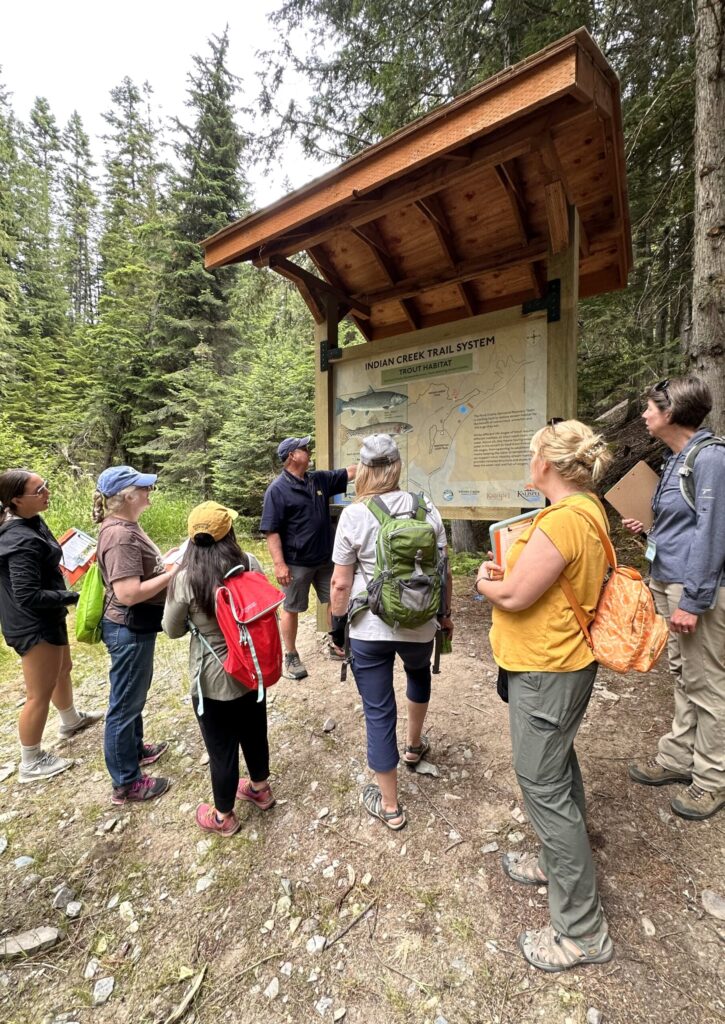Twenty-three K-12 educators from nine school districts in Spokane, Pend Oreille, and Stevens Counties spent two days this June at Kalispel Tribe Indian Creek Community Forest for an Engaging Communities in Forest Education workshop. Pacific Education Institute, Kalispel Natural Resources Department, and Pend Oreille Conservation District hosted and designed the workshop for teachers to gain a deeper understanding of forest resource science and management, learn from forestry professionals, and prepare to bring forest education into the classroom.
Kalispel Natural Resources Department manages the 410-acre Indian Creek Community Forest as an example for local landowners of implementation strategies for forest health and fire resiliency. During the workshop, teachers learned about the multiple agencies and organizations involved in forest management and how they interact. “We introduced them to concepts around managing forests so that they can withstand disease and fire,” says Ray Entz, Director of Wildlife and Terrestrial Resources for Kalispel NRD.
“If kids don’t know and understand nature and forests, they’re not going to appreciate them and they won’t be invested as voters and citizens. They need to be exposed and have experience so that they know what those issues are about.”
— Erin Glasser, Mead Outdoor School Teacher

Participants toured the site’s native plant nursery of riparian and wetland species and learned about management techniques to provide cool water for sensitive native trout species.
They also heard from a panel of forest management experts representing Stimson Lumber, the Washington Association of Conservation Districts, and a small landowner and explored grade-level appropriate forest education resources from Project Learning Tree, an international program that engages children in environmental education through a forestry lens.
Connection was a common thread in post-workshop evaluations, says PEI Eastern Washington FieldSTEM Coordinator Amy Dawley. “We had participants from nine school districts that were primarily small and rural,” Dawley notes. “They said it was impactful for them to have the time to learn about forestry together and realize they’re not alone in their district, trying to create these connections for their students.”
Erin Glasser was one of the participants. Glasser, a secondary teacher at both Mead Outdoor School and Five Mile High School, noticed multiple ways that forestry is relevant for her students. “There are a lot of jobs available in this industry,” she says. “We have students coming through alternative education who need help figuring out what to do after high school. This could be a really good option because there are so many opportunities for employment in this area.”
Even if they choose different careers, students can still benefit from learning about forests, Glasser notes. “If kids don’t know and understand nature and forests, they’re not going to appreciate them and they won’t be invested as voters and citizens. They need to be exposed and have experience so that they know what those issues are about.”
Reaching students is a goal for both Kalispel NRD and Pend Oreille Conservation District. When Stephen Allen started at Pend Oreille CD as an Education Outreach and Administration Coordinator in 2023, his first job was to grow the organization’s formerly robust youth education programming. The workshop was an opportunity to reconnect with former partners and let teachers know about further ways to integrate the conservation district into their curriculum.
“It was a place to start rebuilding that community network while also meeting people who are new to the area,” says Allen. “There is an infrastructure here that we can build on to provide resources for teachers through the conservation district.”
Entz and his team have their hands full managing Indian Creek Community Forest, which leaves little time for connecting with teachers and students. “Our limitation as a bunch of busy biologists is that we don’t necessarily have the right tools in place to do this kind of outreach,” he explains. “This workshop gave us the opportunity to get 24 people on site and give them an understanding that this is their resource.”
Kalispel NRD Information and Outreach Coordinator/Policy Analyst Mike Lithgow agrees. “We’re not an education-based organization,” he

notes. “We do a lot of conservation and science, but we’re not educators and we wanted to give educators a place where they could do their thing.”
Lithgow was there when the seeds of the workshop were planted at an open house in 2012 shortly after Kalispel NRD had acquired the Indian Creek property. “In the beginning, we considered what kind of curriculum we would need to develop to help students get the credits they need. We launched this concept to the community at that open house, and someone from PEI was there. Having PEI host this helps our goal of sharing this place with teachers so that they’ll bring students here. This has been the culmination of a lot of work.”
Based on post-workshop evaluations, they will meet that goal. “This professional learning experience gave me a lot to think about in terms of how I can connect my students more with the outdoors, the Indian Creek Community Forest, and the importance of it all,” one participant says.
“I can’t wait to get my students outside and access our local forestry resources,” another shares. “I am genuinely excited about putting the information and curriculum to use.”
Allen points out that forestry education integrates multiple topics. “When we did our panel, we were talking about civics, environmental case studies, and math in addition to science,” he says. “You can carve an entire year-long curriculum out of this topic, whether you’re an elementary school teacher or a high school teacher.”
